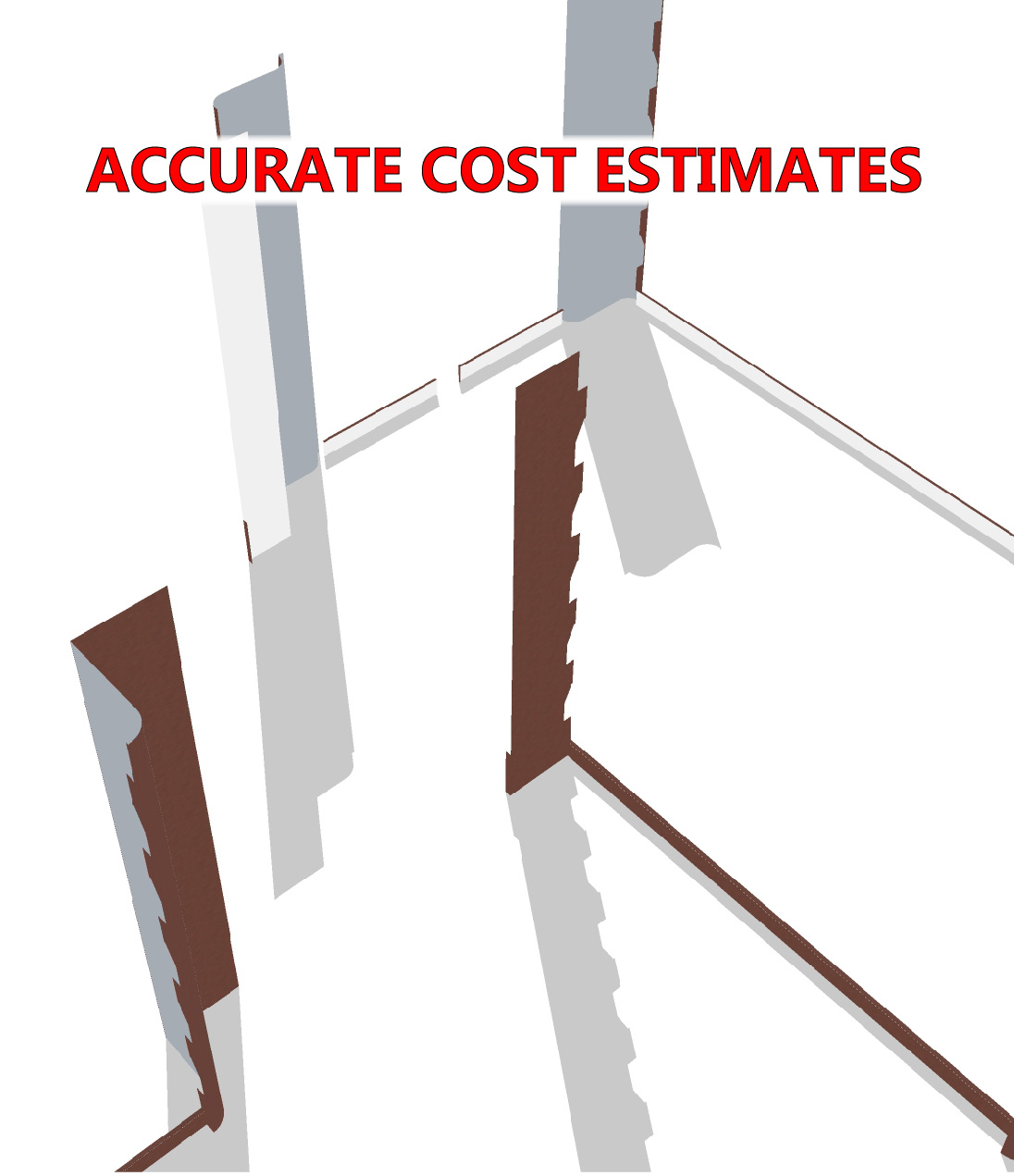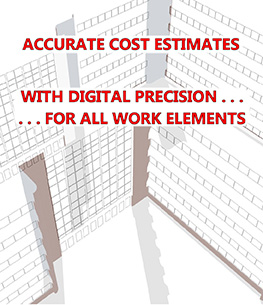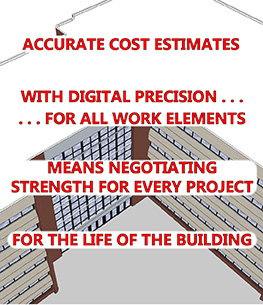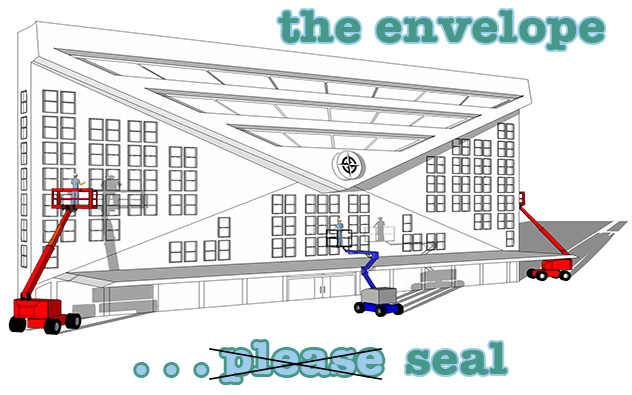STEP 1 In The Commercial Building Restoration Project
THE BUILDING SURVEY & ASSESSMENT
Step 2 – Statement of Work and Specifications
Step 3 – The Bid Process
Step 4 – Project Management & Execution
Theoretically, a properly designed and constructed building that has been well maintained never needs to be inspected. In practice however, whether or not a building leaks, it should be periodically inspected. Of course if there are breaches in the envelope through which air or water pass, especially if it’s water, the locations and reasons need to be ascertained. For most buildings, even if there are no leaks, inspections are needed to determine the envelope’s condition so that failed sealant or other conditions can be discovered before damage occurs.
If certifiable maintenance records don’t exist, surveys and assessments are also called for when buildings are bought and sold. Buyers are being dully diligent when they take the steps needed to determine a building’s condition before making an offer. Consultants with experience bidding restorations contracts are good sources for this service, often called a “Due Diligence Report”.
Sealant doesn’t last forever. Even mortar can eventually fail. Components and assemblies can have design flaws or be improperly installed. Entropy, every physical system’s gradual decline into disorder, is a basic fact that property owners must constantly address. Observation by trained eyes followed by interpretation by the attached mind can prevent what is otherwise inevitable chaos. Building inspection is the first step in controlling the inexorable effects of nature.
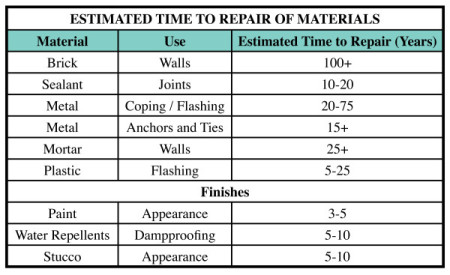
Although the cosmic principles are inescapable, building maintenance and property ownership require pragmatic methods. Organizations like ASTM (American Society for Testing and Materials) and The Brick Industry Association, along with many more similarly venerable and prosaic institutions, address the need by defining standards that contractors can follow and architects, professional engineers and consultants can specify.
Survey Process
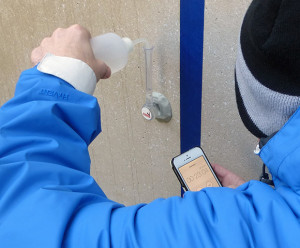
The surveyor of a building envelope examines the building’s joints, its surfaces and its components. To a trained eye, the condition of these building elements provide insight into other matters. The inspection is part of an investigation so in addition to examining the building itself, the surveyor will speak with the building’s occupants and guardians. The people who work in the building, especially if they’ve been there for years can be very informative so a proper survey will include conversations with them. The building engineer might know details about the building envelope, interior and the roof and where there are problems. Occupants know leak locations, their severity and even the conditions that existed when the leak occurred. A thorough survey will also include a review of the building’s service history and examination of the construction drawings.
Property managers know what’s needed and they strive to keep those needs met. They’re a bit like parents when it comes to caring for their buildings. Fulfilling that responsibility means that they know the building’s history so the surveyor will want to hear from them.
Budgets and the limits that the available resources impose are facts of life as inescapable as entropy but they should not bear on how the survey is conducted because the purpose is to identify everything that needs to be restored or corrected. The consultant’s analysis and recommendations are among the things the owner will consider as he decides what to include in the current Scope of Work and what to put off until later.
Occasionally the survey is easy. Well designed buildings, even if they’re old, may only need sealant replacement and paint. Sometimes all the needed observations can be made from the ground and the roof. Various tests are typically conducted to determine the condition of existing sealants and coatings, many of which are simple and don’t even require test equipment. Sometimes buildings have multiple problems and need multiple services. In those cases the survey will be proportionally more involved and may require the use of aerial lifts, scaffolding and special tests. On occasion, to be able to diagnose the cause of leaks and other problems, minor demolition may even be recommended.
Analysis and Assessment – STEP 1.2
If the building is large enough and the source of enough revenue to warrant employing a professional service the survey will take more than a few hours. If his report is to serve as the basis for a Scope of Work the inspector will go back and forth from walls, to drawings, to the building engineer, to all sources, repeatedly, until he knows what’s wrong and what’s needed. Everything depends on the survey so it needs to be complete and accomplished with care. This report by JVS Building Services is a good example of comprehensive report on the condition of two pre-cast concrete buildings in an office complex in California.
With the information from the survey in mind the analysis can be conducted although the two activities aren’t entirely separate (so they shouldn’t be conducted by different professionals). Throughout the process the “surveyor” will analyze his observations and the “analyst” will return to the survey for verification. The analysis requires applying what’s been observed to what’s known about the building’s waterproofing systems and components. If the “as built” drawings are available they can be used in conjunction with the survey data to determine why there are leaks or air infiltration. If drawings aren’t available (and they often aren’t) direct observation of the building’s elements behind the finished surfaces is necessary. This doesn’t often require demolition, but it may. In those cases, particularly if it’s believed design or construction errors are the cause of leaks licensed design professionals may be needed to investigate and solve the problems. Fortunately, most buildings are properly designed and well built and leaks, if they exist, can be corrected with more or less standard maintenance and repair operations.
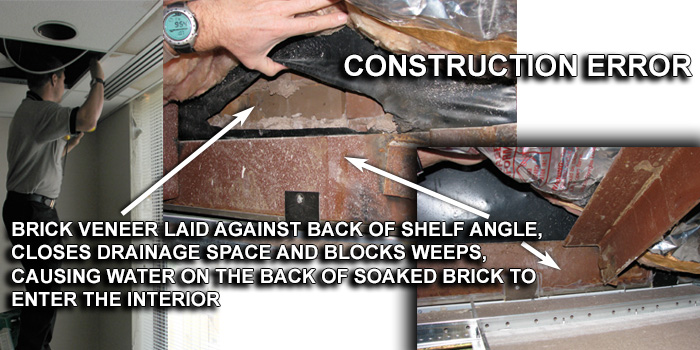
There were construction errors in the case pictured above and documented in this report. The brick veneer was installed too far back on the shelf angle, closing the space behind the brick that the building design called for. Without that path, wind driven rain that penetrated the brick and couldn’t escape through the weeps made its way to the interior.
The findings resulting from the survey done on a financial institution’s call center in Connecticut are representative of a more common outcome. In that case the building needed standard services including sealant restoration, concrete repair, paint and restoration of some miscellaneous metals. Click here to see the pictorial representation of that report. To facilitate the budget for the restoration work a 3D model of the building was created. The video below shows how the model supports budgeting and contract negotiations.

